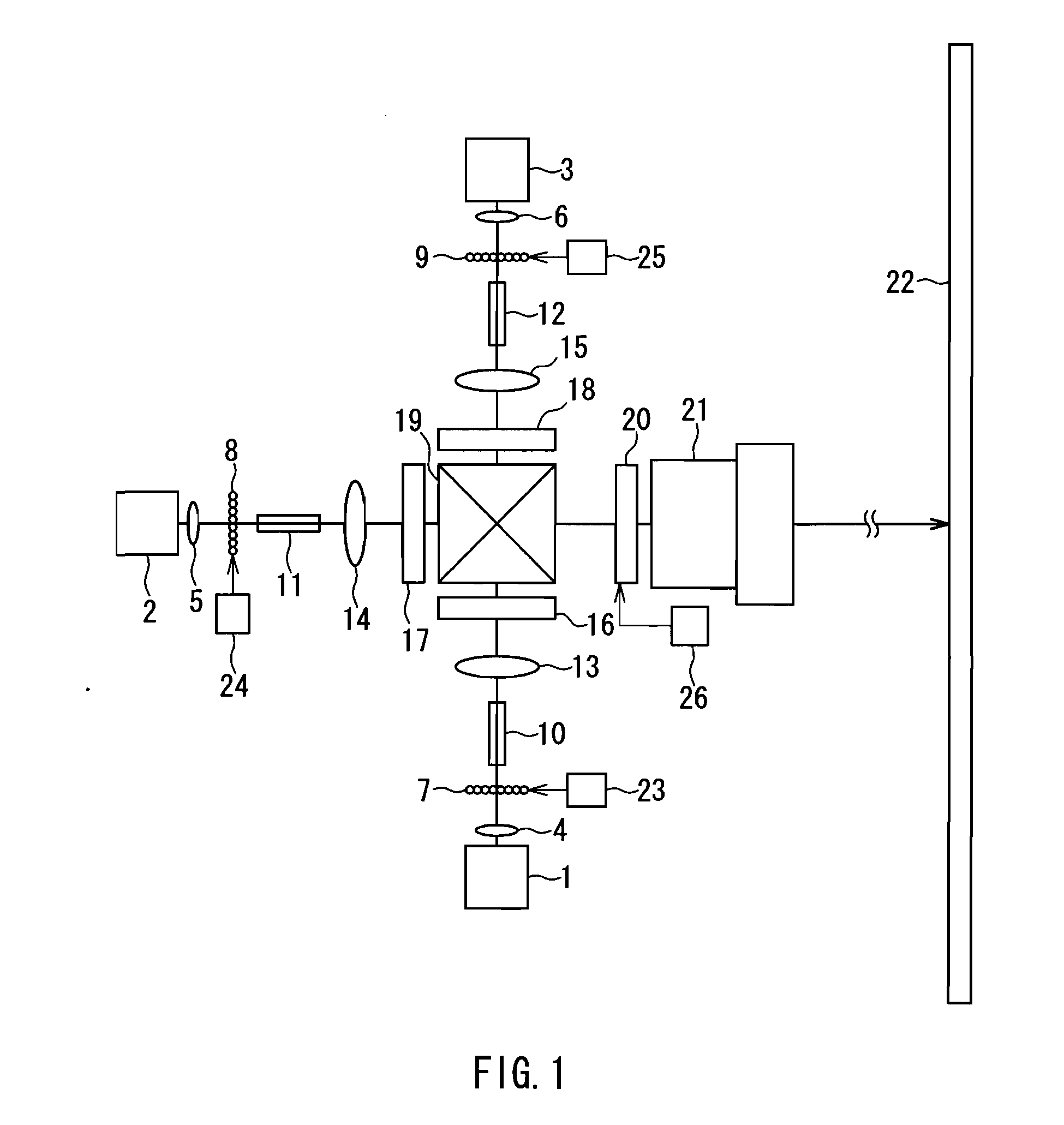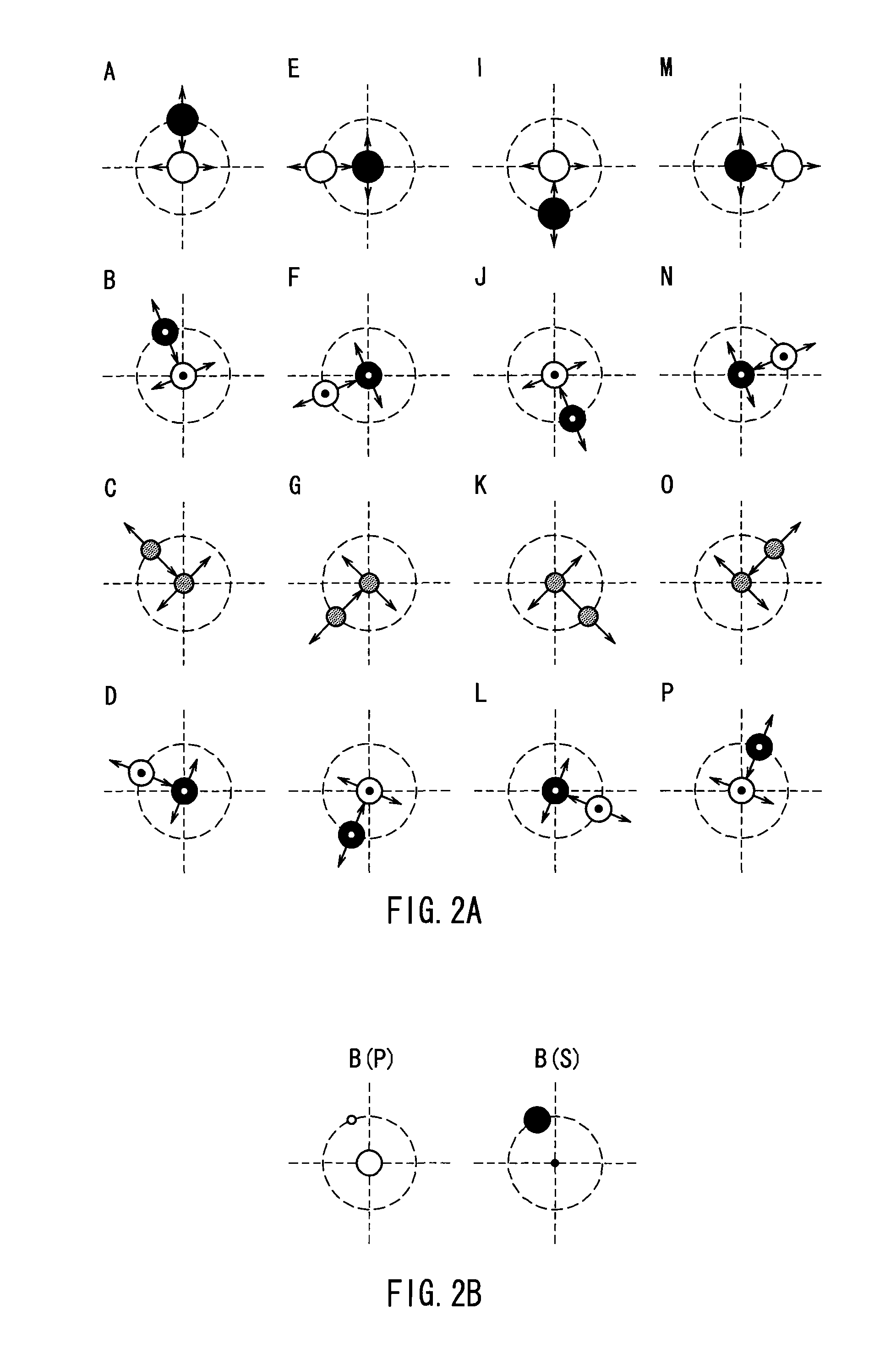Projection type image display device
a projection type, image display technology, applied in the direction of optics, instruments, optical elements, etc., can solve the problems of short useful life, burdensome maintenance of light sources, and deterioration of image quality, so as to reduce speckle noise and less conspicuous pixels
- Summary
- Abstract
- Description
- Claims
- Application Information
AI Technical Summary
Benefits of technology
Problems solved by technology
Method used
Image
Examples
embodiment 1
[0068]FIG. 1 is a diagram that describes a projection type image display device used in Embodiment 1 of the present invention. Three color laser light sources, i.e. red, green, and blue, are used in this embodiment. For example, a semiconductor laser that emits directly a laser light having a wavelength of 638 nm is used as a red laser light source 1, the second harmonic of an Yb fiber laser having a wavelength of 532 nm is used as a green laser light source 2, and a semiconductor laser that emits directly a laser light having a wavelength of 445 nm is used as a blue laser light source 3.
[0069]It should be obvious, however, that laser light sources suitable for carrying out the present invention are not limited to the laser light sources illustrated in this embodiment. For instance, the second harmonic of a near-infrared semiconductor laser can be used as the red laser light source 1. A semiconductor laser that lases directly in the green, the second harmonic of a near-infrared semi...
embodiment 2
[0097]FIG. 3 is a diagram that describes a projection type image display device used in Embodiment 2 of the present invention. This embodiment differs from Embodiment 1 in that a phase retardation plate 27 is added between the beam combining prism 19 and the birefringent plate 20. Accordingly, the same reference numerals are assigned to the same components as the components used in Embodiment 1, and the corresponding descriptions are omitted.
[0098]The phase retardation plate 27 is a quarter-wave plate that generates a phase difference of π / 2 between the S-polarization direction and the P-polarization direction. As it passes through the phase retardation plate 27, the polarization state of the red, green, and blue laser light is converted from linearly polarized light to circularly polarized light.
[0099]FIG. 4 shows a schematic illustration of the pixel patterns formed by light exiting from the birefringent plate 20 in the present embodiment. In the same manner as in FIG. 2, the 16 p...
embodiment 3
[0102]FIG. 5 is a diagram that describes a projection type image display device used in Embodiment 3 of the present invention. This embodiment differs from Embodiment 2 in that the birefringent plate 28, which constitutes a pixel separation element, is made up of three closely spaced first to third birefringent plates 28a-28c. The use of the first, second and third birefringent plates 28a-28c allows for spatially separating the pixel patterns into four pixels.
[0103]The arrangement of the birefringent plates used in this embodiment will be described in more detail below. The circularly polarized red, green, and blue light exiting from the phase retardation plate 27 impinges upon the first birefringent plate 28a, whereupon the light that exits from the first birefringent plate 28a impinges upon the second birefringent plate 28b and the light exiting from the second birefringent plate 28b impinges upon the third birefringent plate 28c. The optic axis of the second birefringent plate 28...
PUM
 Login to View More
Login to View More Abstract
Description
Claims
Application Information
 Login to View More
Login to View More - R&D
- Intellectual Property
- Life Sciences
- Materials
- Tech Scout
- Unparalleled Data Quality
- Higher Quality Content
- 60% Fewer Hallucinations
Browse by: Latest US Patents, China's latest patents, Technical Efficacy Thesaurus, Application Domain, Technology Topic, Popular Technical Reports.
© 2025 PatSnap. All rights reserved.Legal|Privacy policy|Modern Slavery Act Transparency Statement|Sitemap|About US| Contact US: help@patsnap.com



